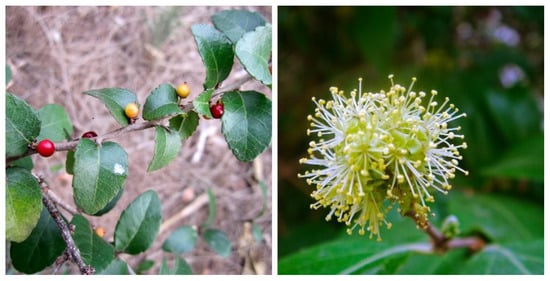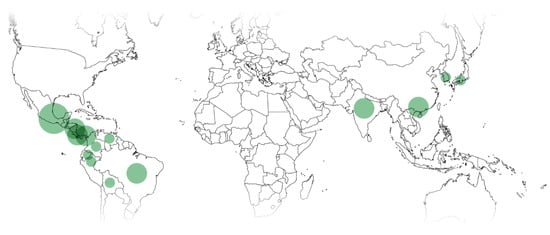You're using an outdated browser. Please upgrade to a modern browser for the best experience.
Please note this is an old version of this entry, which may differ significantly from the current revision.
Subjects:
Chemistry, Medicinal
The Salicaceae Mirb. family, to which the Xylosma genus belongs, is famously medicinal because of the Salix genus (willow), the pharmacological properties of which were already used in ancient Mesopotamia, and were extolled in the first century CE, in Dioscorides’ De Materia Medica.
- Xylosma
- ethnopharmacology
- phytochemicals
- Salicaceae
1. Genus
The Salicaceae Mirb. family, to which the Xylosma genus belongs, is famously medicinal because of the Salix genus (willow), the pharmacological properties of which were already used in ancient Mesopotamia, and were extolled in the first century CE, in Dioscorides’ De Materia Medica [8,9].
The Xylosma genus is one of the 55 that conform the Salicaceae family [9], and is composed of 100 accepted species [10], although others list 45 [11]. Until recently, it was included in the now-deprecated Flacourtiaceae family, but has now been assigned to Salicaceae [12]. The name stems from the Greek words for “wood” and “smell” in reference to odoriferous quality of the wood of some Pacific species of the genus [11], presumably X. orbiculata and X. suaveolens used to perfume coconut oil by early South Pacific inhabitants [13]. At first, the genus was named Myroxylon (myrrh-wood) but was changed to Xylosma to avoid confusion with South American balsam trees [14]. Not all species in the genus are sweet-smelling: X. maidenii timber, for example, is foul-smelling. Xylosma species are described in detail by Woodson et al. [15].
In shrubs or small trees, often with axillary spines, the branchlets commonly lenticellate. Leaves alternate, sometimes borne in fascicles, usually short-petiolate, estipulate, the blade is often ±coriaceous, usually glandular-dentate, penninerved, rarely entire-margined, without pellucid-glands. Inflorescences axillary, fasciculate or contracted-racemose, and are rarely racemose. Flowers are small, dioecious, or rarely polygamous; pedicels are articulated above the base, and the bracts are minute; sepals 4-5(-6), imbricate, usually scale-like, slightly connate at the base, often ciliolate along the margins, usually persistent; petals none; stamens ∞ (8–35 in Panamanian spp.), usually surrounded by an annular or glandular, fleshy disc, the filaments free, filiform, short- to usually long-exserted, the anthers minute, basifixed, extrose, longitudinally dehiscent; ovary sessile, inserted on an annular disc, 1-locular, with 2–3, rarely 4–6, parietal placentas, each placenta with 2, sometimes 4–6, ovules, the style entire or ±divided, sometimes very short, the stigmas scarcely dilated to dilated; rudimentary ovary wanting in male flowers. Fruits baccate, rather dry, indehiscent, surmounted by the persistent style, the pericarp rather thin-coriaceous, the seeds 2–8, +angular by mutual pressure, the testa thin; endosperm copious; embryo large, the cotyledons broad.
Species in the Xylosma genus have several uses and properties, from landscaping (Xylosma congesta (Lour.) Merr.), beekeeping (Xylosma venosa N. E. Br. [16]), timber, firewood, to food and medicine; notably Xylosma longifolia Clos. Due to the thorns that some species of the genus have, common names such as “do not touch me” (Xylosma coriacea (Poit.) Eichler) or “deer antlers” (Xylosma spiculifera (Tul.) Triana and Planch.) are used for them [17]. Eleven species of the genus, particularly Xylosma vincentii Guillaumin, are known to be nickel hyperaccumulators [18,19] which presents potential for phytoremediation and phytomining [20].
2. Distribution and Localization
Species belonging to the Xylosma genus are present in subtropical America, Southeast Asia, and Oceania. Of the 100 species listed in the genus [10], 61 are found in America, 8 in Asia, and 31 in Oceania. Figure 1 shows examples of species of the genus. The map in Figure 2 shows the intertropical, and to a lesser extent, temperate, distribution of Xylosma species, by country.

Figure 1. Xylosma flexuosa (Kunth) Hemsl. leaves and berries, left. Xylosma congesta (Lour.) Merr. inflorescence, right. Image sources: left, Public Domain (CC0); right, Miwasatosi, GDFL license.

Figure 2. Worldwide Xylosma distribution, by country, after [10].
Of the 100 species of the genus, 7 are listed as vulnerable, 9 as endangered, and 6 as critically endangered. In total, 22% of the species in the genus are considered as species of concern [21]. This should be considered when evaluating potential industrial uses for these species.
3. Ethnopharmacological and Ethnoveterinary Usage
Of the 100 species of the genus, few appear in the scientific literature, and even fewer are mentioned from an ethnopharmacological or ethnoveterinary perspective. Notwithstanding, Xylosma species are a part of the traditional Chinese medicinal system, with documented uses of X. congesta appearing as early as the XVI century CE [25].
Few of the Xylosma species are recognized as medicinal. Table 1 summarizes the species with reported medicinal use along with their stated ethnopharmacological uses, when available. The Anatomical Therapeutic Chemical (ATC) Classification by the World Health Organization (WHO) is used to classify the uses for each species [26]. Not all species are identified in the literature, with general mentions as “Xylosma sp.” in some cases.
Table 1. Medicinal and veterinary use of Xylosma species, listed in alphabetical order.
| No. | Species | Region | Plant Organs Used | Use | Form of Usage |
ATC Category |
Ref. |
|---|---|---|---|---|---|---|---|
| 1 | Xylosma benthamii (Tul.) Triana and Planch. | Brazil | NS | Medicinal (not specified) |
NS | NS | [27] |
| 2 | Xylosma characantha Standl. | Nicaragua | Leaves | Placentary retention in cattle | Decoction | Vet. | [28] |
| 3 | Xylosma chlorantha Donn. Sm. | Costa Rica | Bark | Medicinal (not specified) |
NS | NS | [29] |
| 4 | Xylosma ciliatifolia (Clos) Eichler | Brazil | Root bark | Antibacterial | NS | V | [30] |
| 5 | Xylosma congesta (Lour.) Merr. | China Japan Korea |
Bark Leaves |
NS Anti-inflammatory Disease prevention in suckling piglets Birthing aid |
Bark ashes Poultice |
NS D G Vet. |
[31] [32] [33] [34] |
| 6 | Xylosma controversa Clos. | Guangxi, China | Roots Leaves |
NS | NS | NS | [35] |
| 7 | Xylosma flexuosa (Kunth) Hemsl. | Mexico | NS | Antipyretic Anti-tuberculosis |
NS | N R |
[36,37] |
| 8 | Xylosma horrida Rose. | Mexico Nicaragua Costa Rica |
Bark | Kidneys | Decoction | G | [38] |
| 9 | Xylosma intermedia (Seem.) Triana and Planch. | Bolivia | Bark | Toothache | NS | N | [39] |
| 10 | Xylosma longifolia Clos | India China |
Leaves Stem bark |
Antifungal Antispasmodic Antidiarrheic Anti-tuberculosis Muscle sprains Narcotic |
Paste Decoction Extract |
D A A R M N |
[40] [41] [42] [43] [44] |
| 11 | Xylosma panamensis (Turcz) | Panama Mexico |
Bark Leaves |
Cough Bronchitis |
Dried | R | [45] |
| 12 | Xylosma spiculifera (Tul.) Triana and Planch | Colombia, Venezuela | Leaves | Ulcers, Dermatitis | Decoction | D | [46] |
| 13 | Xylosma tessmanii Sleumer | Ecuador | Leaves | Medicinal (NS) | NS | NS | [47] |
| 14 | Xylosma sp. (not specified) | Panama | Stem Root |
Spider bites | Infusion | V | [48] |
| 15 | Xylosma sp. (not specified) | Perú | Bark | Bronchitis (with other plant species) | Decoction | R | [49] |
NS: Not specified. ATC categories are as follows. A: Alimentary tract and metabolism, B: Blood and blood forming organs, C: Cardiovascular system, D: Dermatological, G: Genito urinary system and sex hormones, H: Systemic hormonal preparations, excluding sex hormones and insulins, J: Anti-infective for systemic use, L: Antineoplastic and immunomodulating agents, M: Musculo-skeletal system, N: nervous system, P: Antiparasitic products, insecticides, and repellents, R: Respiratory system, S: Sensory organs; V: Various [26]; STDs: Sexually transmitted diseases, Vet: veterinary.
Most Xylosma species in use are from Central and South America (38% and 31%), followed by China (23%) and India (8%). This is roughly in accordance with the local abundance of species. There are no reports of ethnomedicinal uses of Xylosma in Oceania. Uses by country are shown in Figure 4.

Figure 4. Ethnopharmacological and ethnoveterinary uses of Xylosma spp. Circle diameter proportional to use reports for the country.
According to the ATC classification, the most frequent uses of Xylosma spp. in ethnopharmacology are dermatological, nervous system, and respiratory system, with 17% of the uses each, alimentary tract and metabolism with 11%, and genitourinary system and sex hormones with 6%. Additionally, 11% of the uses are veterinary.
As to the morphological structures used, the most common are leaves and barks with 33% each, and both stems and roots with 11% each.
4. Biological Activity
Biological activity tests of Xylosma have been carried out mostly in vitro, with no reported in vivo research, with plant extracts, be they leaf, root, bark, or the whole plant. Different solvents and solvent mixtures have been used for the extracts, mainly methanol and ethanol.
In Vitro Activity
In vitro research on biological activity of Xylosma species centers around 7 identified species and one unspecified one. The research figures are summarized in Figure 5, and the research is detailed in Table 2.

Figure 5. Summary of in vitro activity of Xylosma species.
Table 2. In vitro activity of Xylosma extracts. Species are in alphabetical order.
| Species | Extract | Plant Organs Used | Biological Activity |
Biological Model |
Effect | Methodology | Ref. |
|---|---|---|---|---|---|---|---|
| X. ciliatifolia | Ethanol/Hexane partition | Root bark | Antibacterial | S. aureus S. epidermis S. typihimurium E. coli |
Effective against S. aureus S. epidermis MIC (µg/mL) 250, 500 |
Disk diffusion assay | [30] |
| X. clorantha | Ethanol | Leaves | Metabolic syndrome | HepG2 cells | LXR 2.14 ± 0.11: 100 µg/mL |
LXR transcriptional activity | [50] |
| X. congesta | Ethanol | Leaves | Anti-melanogenic | B16F10 cells | Melanin synthesis inhibition: up to 57.9% | α-MSH | [32] |
| X. intermedia | DCM/Ethanol | Bark | Antibacterial | Bacillus cereus S. aureus |
MIC (ppm) 156 512 |
Microbroth dilution | [51] |
| X. longifolia | Petroleum ether Chloroform Methanol |
Leaves, Stem bark | Antifungal | Microsporum boullardii, M. canis, M. gypseum Trichophyton ajelloi T. rubrum |
MIC (mg/mL) 0.141–9.0 |
Agar diffusion Micro wells diffusion |
[40] |
| X. prockia | Ethanol | Leaves | Antifungal | Cryptococcus spp. | MIC (ppm) 8–64 |
Antifungal microdilution susceptibility standard test | [52] |
| X. terrae reginae | Methanol | Root | Antibacterial Antifungal |
S. aureus C. albicans |
MIC (mg/mL) 2.5 1.2 |
Dilution method | [53] |
| X. sp II | Methanol | Leaves | Antibacterial | Flavobacterium columnae | MIC 375 µg/mL |
Agar diffusion assay | [54] |
DCM: Dichloromethane; MIC: Minimum inhibitory concentration; α-MSH: melanocyte-stimulating hormone. LXR: LXRα Fold Activation.
In vitro biological activity tests devote the most attention to leaves (55%), with bark (33%) and root (11%) used to a lesser extent. Extraction solvents are ethanol (42%), methanol (21%), and to a lesser extent petroleum ether, chloroform, dichloromethane, and hexane, with 8% each. The solvent choices support the assumption that most active compounds are polar, and are thus extracted with polar solvents.
Testing centers on antibacterial (44%) and antifungal (44%) activity reflects the main ethnopharmacological use but appears to leave other traditional uses unexplored.
Cytotoxicity assays involving Xylosma extracts show no significant cytotoxicity for Xylosma prockia nor for Xylosma congesta leaf extracts [52,55]. Moderate cytotoxicity was reported for methanol Xylosma terrae reginae extracts [53]. 2,6-dimethoxybenzoquinone (33) isolated from Xylosma velutina is reported as cytotoxic [56].
Even though there is no in vivo research concerning Xylosma species in the literature, there are several patents that include Xylosma extracts for cosmetic, veterinary, and traditional medicinal uses, such as hangover cures [33].
This entry is adapted from the peer-reviewed paper 10.3390/plants11091252
This entry is offline, you can click here to edit this entry!
